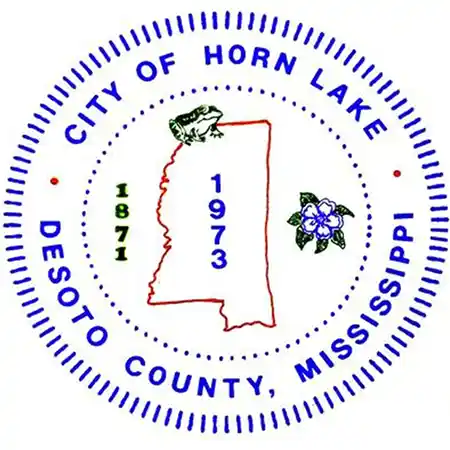The City of Horn Lake, Mississippi was granted the Charter of Decree of Incorporation, March 3rd, 1973, after three (3) years of planning and work. The original governing body consisted of Winn D. Brown, Sr., as mayor, five (5) aldermen, W.R. Wooten, John Sartain, Anna Calvi, F.G. Thomas, and Winn D. Brown, Jr.
Horn Lake received its name from an ox-bow lake, lying three miles west, which was a former riverbed of the Mississippi River. The river changed course in the late 18th century leaving a stranded body of water resembling a cow horn. It became known as Horn Lake. Old maps indicated the date must have been between 1765 and 1796.
In historical times the Chickasaw Indians inhabited the area. Hernando DeSoto and his party, the first Europeans to encounter the Chickasaws wintered with them at the time of his discovery of the Mississippi River. The French Explorer, La Salle, solicited their help on his journey down the Mississippi to the Gulf of Mexico. The area passed through successive Spanish and English rule, finally coming under American governance after the Revolutionary War. In 1832, the Chickasaws relinquished all claims to land east of the Mississippi River by the terms of the Treaty of Pontotoc.
Settlers moving into the area cleared the wilderness and began cultivating subsistence crops. Cotton became the major cash crop. The building of the railroad, the Memphis and Grenada (now the Illinois Central), stimulated growth in the area. Freight marked “Horn Lake”, intended for the families who lived in the lake region, was dropped off on Goodman Road and delivered by horse and wagon. Eventually, the freight stop acquired the name “Horn Lake” and a community grew up as residents built stores, cotton gins, a stockyard, black smith shops and gristmills near the tracks. The first post office was opened December 13, 1853.
Horn Lake is home to several historical sites. The most outstanding of these are the following two homes, which exist today.
 Circle G Ranch (once owned by Elvis)
Circle G Ranch (once owned by Elvis)
Elvis’ involvement with the ranch began early in 1967 when whilst out on a trip to the country to buy more horses for his growing stable, he came across the ranch, then named ‘Twinkletown Farm”. We are told that it was the sight of the large white cross that caught his attention and Elvis purchased the property on the spot from Jack Adams for $437,000 USD.
Elvis wanted to name the ranch The Circle G but when he tried to register it under that name it was discovered that another ranch already existed using that name – the ranch was in fact registered under the name “The Flying Circle G Ranch”.
In the coming days and weeks Elvis purchased several mobile homes so that his friends could stay on the ranch with him. He also bought several vehicles, agricultural equipment and a small herd of cattle. Once the 3m fence was erected around the property Elvis and his friends and family began to enjoy their new ‘country retreat’.
Circle G House & Guard Shack
After Elvis’ marriage to Priscilla on 1st May 1967 they spent a few days in Palm Springs and then they returned home to the ranch on or about May 4th. Ever since then the ranch house has been known as Elvis’ honeymoon cottage.
Elvis enjoyed the seclusion of the ranch and the wide-open spaces. They held barbeques, fooled around on the farming equipment and spent many hours ‘riding the range’ until Elvis sold the ranch on May 20, 1969.
Circle G - Cross
 Octagonal House
Octagonal House
Built in 1844 by Dr. Nathaniel Raines as a gift to his bride, Ann Eldridge, this unusual tree-level, eight-sided house is located on Horn Lake Road just south of Nail Road. Construction of the house was under the direction of William Gwinn. The original house was beautifully finished inside and out. Mr. Bryan Swilly has restored it to the grandeur it deserves.
Gayoso Farms
The billboard was spectacular in a day when billboards were few and far between. Bright and colorful, it pictured a prize-winning Guernsey cow and pure-bred Hampshire hog; it graced the roadside of Highway 51 going south from Bull Frog Corner. Local citizens and those from afar were drawn to the east side of that road….there lay Gayoso Farms in all its splendor…beautiful green pasture lands dotted with grazing cattle.
Those who wished to see more of this unusual place traveled east on Goodman Road, which was the north boundary of its acreage. No expressway existed when the farm was in its heyday during the twenties and through the late thirties. A unique kingdom all its own, the farm had headquarters facing Goodman Road, though back some distance from the traffic dust. Elaborate barns for every need; hog facilities to equal those of the cattle; gardens, feed crops, silos, deep wells, a business office, managers’ homes, and The Boarding House were all clustered in a well-planned arrangement. In addition, scattered throughout the property, with some even across Goodman Road, were neat family homes painted gray with white trim like the Boarding House. All boasted neat yards….and happy families loyal to the Ulken Brothers, farm and dairy experts brought from Germany to manage Gayoso Farms, a project owned by several Memphis hotel systems. Descendants of some of those early Gayoso Farm families remain in this area today.
Known throughout the South for the famous “Golden Guernsey Milk” its cattle produced, this farm provided its owners with an abundance of that milk for those Memphis hotels. At times there were also fresh vegetables for the hotel dining rooms. The only public retailer of this much sought-after milk was Bull Frog Corner in Horn Lake.
Many employees of the farm were single men, who could live upstairs at the two-story boarding house. Lunch time was a bountiful feast prepared and served by the farm’s official cook, and enjoyed by managers, resident employees, and the farm secretary, who presided over that table as well as the office.
Always there was an air of excitement around the farm: baby calves with special pedigrees; cattle and hogs that raked in all the honors from Mid South Fair, enhancing the farm’s world-wide reputation for fine, pure-bred animals and startling milk production records. There were even a Gayoso Farms romance, culminating in the wedding of the farm secretary and one of the Ulkens.
That historic honeymoon provided for a local teenager to experience the inner workings of the well-organized business. Having giggled her way through high school typing and shorthand classes, this young lady was startled to be named (by the teacher) as a possible “fill-in” while the bride and groom vacationed. What an education this proved to be!
This wide-eyed substitute saw correspondence from all over the world. A manager would take the letters of foreign origin into Memphis, where translators would change them into readable English and return them to the farm office. Replying in dictated English to the quests for registered breeding stock, both cattle and hogs, the office force began the reverse procedure….writing in English and imagining how Russian…or perhaps Japanese….translators would have to decipher the reply for the interested party.
This new secretary was startled that the manager in charge vetoed her plans to “go home for lunch.” At this request she timidly joined the otherwise-all-male diners around the long boarding house table. A typical feast, served by the official cook, consisted of great loaded platters of perfect fried chicken; huge bowls of fluffy creamed potatoes, green beans fresh from their gardens, and the crowning glory…stacked up and steaming hot ears of yellow corn dripping with Golden Guernsey Butter; then, perhaps a peach cobbler to make the meal complete. To this day, her companions’ friendly teasing lingers in that no-longer teenager’s mind: “Come on! Dig in! You’ve got to get butter on your ears!”
This brief glimpse of the inside workings depicts only a moment in the complete story of Gayoso Farms. Sold numerous times, there were later owners, varied projects and goals, significant occupants with their personal contributions of talent and ideas to the community. This account, however, pictures the years of the farm’s world-wide recognition…..years when Horn Lake School’s classrooms were filled with many children who, in answering a question of residence, proclaimed, “GAYOSO FARMS” as home. A new modern highway has taken much of the farm land; remaining acreage is now used the many ways decreed by developers. The “farm” designation is no more…except for the memories of those who experienced life there.
The Walker Home
It was originally a four-room log house, one and one-half stories built by Mr. Shannon, a nephew of Mrs. Jewell Walker. She and her family came to this county from Franklin, Tennessee in 1844. Mrs. Jewell Walker, grandmother of the Misses Walker, first lived in a log cabin a few yards from the present house. Logs and bricks used in building the house were hewn and made on the place. Among the historic furnishings of the home is an interesting piano purchased when the first carpetbagger government was overthrown in 1875. On being forced to leave in a hurry, a carpetbagger, living at the site of the Winn D. Brown home, had an auction of his household goods and the mother of the Misses Walker bought the piano.

